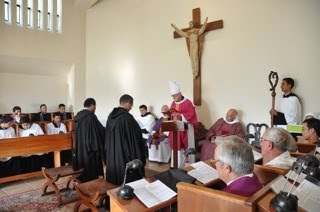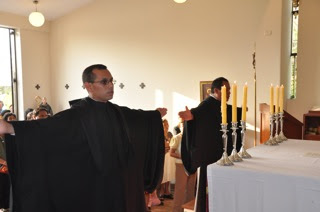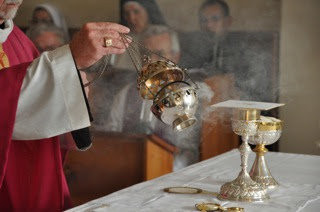After the Gospel they were asked what they wanted from God and the Church; and they answered, "Perseverance to serve God in this monastic community all the days of their lives. The Gospel reading had been about the raising of Lazarus. Abbot chose to comment on the sentence "Did I not tell you that, if you have faith, you will see the Glory of God?" He said that this is what monastic and religious life is all about: it is a life of faith in which the monks will see the Glory of God, not just in the next life, but in the present life, in the faces of their neighbours and in the intimacy of interior prayer.
Here
D. Percy is reading out aloud his vows and D. Wilmer is waiting to do
so. After reading out his vows, Wilmer signs the document. The Abbot
had explained that the monastic formula is not three separate Christian
Christian vows as in the "Poverty, Chastity and Obedience", which is of
Franciscan origin. It is one single commitment to monastic life,
expressed in the Latin phrase "Conversatio morum", which includes
chastity and austerity of life and conversion"; "Obedience" which not
only promises to obey the abbot and his successors, but also a general
openness toGod's will, however it presents itself; and "Stability"
which is a commitment to do this within the context of a particular
community. Just as a man commits himself to one particular community
in marriage, so the Benedictine monk commits himself to one particular
community.
Here, D. Percy is signing the document from which he read his vows. It is written in his handwriting and will be placed under the pall on which the gifts of bread and wine are placed, together with that of D. Wilmer. Thus their vows are associated with Christ's sacrifice on the cross which is celebrated at the Mass. The documents are also signed by Fr Abbot and by me as the local superior
Now comes a dramatic part of the ceremony when, according to the Rule of St Benedict, the two sing a verse from Scripture three times, first at the door of the chapel, secondly in the aisle, and thridly in front of the altar, each time on a higher note; and it is repeated by the monastic choir. The music was composed by Peter Abelard when he was an abbot for Heloise who had become an abbess.
"Suscipe me, Domine, secundum eloquium tuum et vivam; et non confundas me ab expectatione mea!"
"Support me, Oh Lord, according to your promise that I may live, so that my hope will not be frustrated."
"Support me, Oh Lord, according to your promise that I may live, so that my hope will not be frustrated."
Having sung the verse three times, they lie down under a pall, symbolically dead to the world which has been closed in on itself by sin; and the community sing the Litany of the Saints for the two new life members of the monastic communi
After the Litany of the Saints, the two monks receive a solemn blessing from the abbot who asks for them all the monastic virtues and, above all, the Holy Spirit. They are declared to be members of the monastic chapter, and they are embraced by the community.
Our "Father Bishop", important guest number two, who is a very saintly Salesian who, as Bishop of Lurin, was one of the factors that drew us here. He is now retired and is our confessor; and he is present at all our most important functions. He is embracing Percy.
Now
the Eucharist begins, and the abbot salutes the altar. The altar is
the liturgical centre of the liturgy: like the Holy of Holies which was
the mercy seat, the place of God's covenanted presence in the temple
because of the sacrifice of atonement offered there by the High Priest:
so is the altar in reality what the Holy of Holies was in shadow.
The altar is the throne of God because of the rtue sacrifice of
atonement is offered there. It is the extension of the cross of
Christ, because the victim is laid on it during the offering. It is
the table at which Wisdom offers succulent food to her children. It
is the liturgical East towards which both priest and people face in
both the ordinary and extraordinary versions of the Latin Mass.
After Communion, the two monks present themselves; and the Abbot pins up their hoods. Fot three days they will go around with their hoods up; and they will keep absolute silence in what is probably the best retreat in their lives. The hoods are unpinned after communion on the third day, and the community welcome them.
The Abbot leaves at the end of the procession. The two monks have already left so as not to be caught up by people who wish to talk to them. (taken from THE PACHACAMAC POST)

























